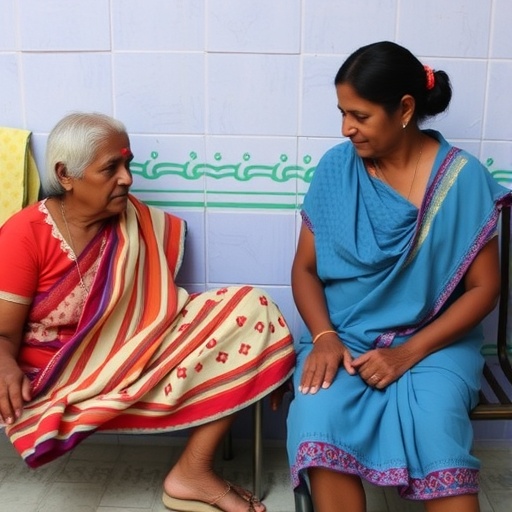In an era where longevity is celebrated, the intriguing paradox of health disparities between men and women continues to puzzle researchers globally. A recent groundbreaking study published in Genus by Karun, McDougal, and Singh ventures into this enigmatic territory, focusing on India’s older adults. Their paper meticulously explores the sex disparities in health, emphasizing the so-called morbidity-mortality paradox by assessing disability-free life expectancy (DFLE). This detailed analysis sheds new light on the intricate dynamics of aging, mortality, and health quality, offering insights that transcend geographical and cultural boundaries.
The morbidity-mortality paradox describes the phenomenon where women tend to live longer than men but experience higher levels of disability and poorer health during their extended years. This paradox poses profound questions about the nature of aging and the factors contributing to sex-based health differentials. The authors harness extensive demographic data to dissect how this paradox manifests in one of the world’s most populous countries, India, where social, economic, and cultural influences distinctly shape health outcomes.
Through sophisticated statistical modeling and longitudinal data analysis, the study measures life expectancy free from disabilities, thus shining a vital spotlight on not just lifespan, but health span—the period during which individuals maintain functional independence. The findings challenge simplistic notions that longer life invariably equates to healthier life, instead revealing a nuanced landscape where men and women experience aging differently, shaped by biology and societal roles.
In India, rapid demographic shifts have led to a burgeoning elderly population, intensifying the need to understand their health trajectories. The authors argue that while women’s longevity advantage is evident, their higher burden of disability imposes significant health care challenges. This disability burden is not merely a biological inevitability but is intricately linked to gender norms, access to healthcare, nutritional status, and psychosocial factors pervasive across Indian society.
The paper meticulously quantifies DFLE across sexes, uncovering stark contrasts. Indian women tend to outlive men by several years, yet spend a larger proportion of those additional years with disabilities. This pattern underscores persistent gender inequalities in health that are often masked by conventional mortality statistics. The implications are profound: public health policies must pivot from mortality reduction alone to encompass strategies enhancing quality of life and functional capacity in later years.
Diving deeper, the authors hypothesize that biological differences, such as hormonal influences and genetic factors, may confer women with greater resilience against fatal diseases, explaining their longevity. However, this advantage is counterbalanced by socio-environmental determinants that elevate women’s risk for non-fatal chronic conditions leading to disability. Factors including differential exposure to domestic labor, nutritional deficiencies, and limited access to healthcare exacerbate women’s vulnerability.
Moreover, the study critiques existing health metrics, advocating for the integration of DFLE into routine demographic analyses. By doing so, policymakers and health practitioners can garner a comprehensive picture of aging populations, enabling targeted interventions. This is especially critical in countries like India, where health infrastructure varies drastically, and women often face systemic barriers to care.
The researchers employ rigorous methodologies, utilizing data from national health surveys and census records to construct robust life table analyses. Their methodological rigor allows them to isolate the influences of sex on disability prevalence independent of other confounding variables. This clarity highlights the systemic nature of sex disparities in health rather than attributing them solely to personal or genetic factors.
Importantly, the paper emphasizes the role of non-communicable diseases (NCDs), which disproportionately affect older women in India. Conditions such as arthritis, hypertension, and diabetes contribute significantly to prolonged disability periods. This epidemiological shift from infectious diseases to chronic ailments poses novel challenges, compelling health services to adapt their prevention and treatment strategies with a gender-sensitive lens.
The authors also stress the social dimensions impacting health outcomes. Gender roles in the Indian context often confine women to caregiving and household duties with limited autonomy. These roles restrict opportunities for physical activity and social engagement, factors essential for healthy aging. Psychological stress and reduced social support further compound women’s health disadvantages, perpetuating the morbidity-mortality paradox.
The paper’s implications extend beyond demographics, calling for transformative policy frameworks. Interventions focusing on improving women’s nutrition, ensuring equitable access to health services, and promoting social inclusion could alleviate the disability burden. Simultaneously, targeted male health programs aimed at reducing mortality risks—such as cardiovascular diseases and accidents—are crucial for narrowing longevity gaps.
Throughout the discussion, the authors also touch upon the intersectionality of socioeconomic status with sex, revealing that poorer women experience disproportionately worse health outcomes. This intersection amplifies inequalities and demands nuanced policy solutions capable of addressing multiple layers of disadvantage.
Their investigation highlights an urgent need to refocus aging research within India and similar contexts, drawing attention to the complex interplay between biology, environment, and social structures. By framing the morbidity-mortality paradox through the lens of disability-free life expectancy, Karun and colleagues provide a powerful narrative that moves beyond mortality statistics toward richer understandings of healthy aging.
In conclusion, this study represents a pivotal step toward unraveling the multifaceted health disparities faced by older adults in India. Its insights carry global resonance, as aging populations worldwide grapple with similar sex-specific health challenges. By centering disability-free life expectancy, the research champions a holistic approach to geriatric health that balances longevity with quality of life—an imperative as humanity navigates the complexities of aging in the 21st century.
Subject of Research:
Sex disparities in health among older adults in India; analysis of the morbidity-mortality paradox through disability-free life expectancy.
Article Title:
Sex disparities in health of older adults in India: assessing the morbidity-mortality paradox through disability-free life expectancy.
Article References:
Karun, S., McDougal, L. & Singh, A. Sex disparities in health of older adults in India: assessing the morbidity-mortality paradox through disability-free life expectancy. Genus 81, 11 (2025). https://doi.org/10.1186/s41118-025-00247-2
Image Credits:
AI Generated




